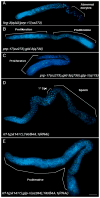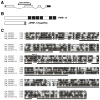PRP-17 and the pre-mRNA splicing pathway are preferentially required for the proliferation versus meiotic development decision and germline sex determination in Caenorhabditis elegans
- PMID: 20419786
- PMCID: PMC3097115
- DOI: 10.1002/dvdy.22274
PRP-17 and the pre-mRNA splicing pathway are preferentially required for the proliferation versus meiotic development decision and germline sex determination in Caenorhabditis elegans
Abstract
In C. elegans, the decision between germline stem cell proliferation and entry into meiosis is controlled by GLP-1 Notch signaling, which promotes proliferation through repression of the redundant GLD-1 and GLD-2 pathways that direct meiotic entry. We identify prp-17 as another gene functioning downstream of GLP-1 signaling that promotes meiotic entry, largely by acting on the GLD-1 pathway, and that also functions in female germline sex determination. PRP-17 is orthologous to the yeast and human pre-mRNA splicing factor PRP17/CDC40 and can rescue the temperature-sensitive lethality of yeast PRP17. This link to splicing led to an RNAi screen of predicted C. elegans splicing factors in sensitized genetic backgrounds. We found that many genes throughout the splicing cascade function in the proliferation/meiotic entry decision and germline sex determination indicating that splicing per se, rather than a novel function of a subset of splicing factors, is necessary for these processes.
Copyright (c) 2010 Wiley-Liss, Inc.
Figures






Similar articles
-
Germline Stem Cell Differentiation Entails Regional Control of Cell Fate Regulator GLD-1 in Caenorhabditis elegans.Genetics. 2016 Mar;202(3):1085-103. doi: 10.1534/genetics.115.185678. Epub 2016 Jan 12. Genetics. 2016. PMID: 26757772 Free PMC article.
-
Analysis of the multiple roles of gld-1 in germline development: interactions with the sex determination cascade and the glp-1 signaling pathway.Genetics. 1995 Feb;139(2):607-30. doi: 10.1093/genetics/139.2.607. Genetics. 1995. PMID: 7713420 Free PMC article.
-
Multi-pathway control of the proliferation versus meiotic development decision in the Caenorhabditis elegans germline.Dev Biol. 2004 Apr 15;268(2):342-57. doi: 10.1016/j.ydbio.2003.12.023. Dev Biol. 2004. PMID: 15063172
-
The regulatory network controlling the proliferation-meiotic entry decision in the Caenorhabditis elegans germ line.Curr Top Dev Biol. 2006;76:185-215. doi: 10.1016/S0070-2153(06)76006-9. Curr Top Dev Biol. 2006. PMID: 17118267 Review.
-
Stem cell proliferation versus meiotic fate decision in Caenorhabditis elegans.Adv Exp Med Biol. 2013;757:71-99. doi: 10.1007/978-1-4614-4015-4_4. Adv Exp Med Biol. 2013. PMID: 22872475 Free PMC article. Review.
Cited by
-
Mechanisms of germ cell survival and plasticity in Caenorhabditis elegans.Biochem Soc Trans. 2022 Oct 31;50(5):1517-1526. doi: 10.1042/BST20220878. Biochem Soc Trans. 2022. PMID: 36196981 Free PMC article. Review.
-
Diverse Roles of PUF Proteins in Germline Stem and Progenitor Cell Development in C. elegans.Front Cell Dev Biol. 2020 Feb 6;8:29. doi: 10.3389/fcell.2020.00029. eCollection 2020. Front Cell Dev Biol. 2020. PMID: 32117964 Free PMC article. Review.
-
CACN-1 is required in the Caenorhabditis elegans somatic gonad for proper oocyte development.Dev Biol. 2016 Jun 1;414(1):58-71. doi: 10.1016/j.ydbio.2016.03.028. Epub 2016 Apr 1. Dev Biol. 2016. PMID: 27046631 Free PMC article.
-
TRIM-NHL protein, NHL-2, modulates cell fate choices in the C. elegans germ line.Dev Biol. 2022 Nov;491:43-55. doi: 10.1016/j.ydbio.2022.08.010. Epub 2022 Sep 3. Dev Biol. 2022. PMID: 36063869 Free PMC article.
-
Schistosome W-Linked Genes Inform Temporal Dynamics of Sex Chromosome Evolution and Suggest Candidate for Sex Determination.Mol Biol Evol. 2021 Dec 9;38(12):5345-5358. doi: 10.1093/molbev/msab178. Mol Biol Evol. 2021. PMID: 34146097 Free PMC article.
References
-
- Ahringer J, Kimble J. Control of the sperm-oocyte switch in Caenorhabditis elegans hermaphrodites by the fem-3 3′ untranslated region. Nature. 1991;349:346–348. - PubMed
-
- Austin J, Kimble J. glp-1 is required in the germ line for regulation of the decision between mitosis and meiosis in C. elegans. Cell. 1987;51:589–599. - PubMed
-
- Austin J, Kimble J. Transcript analysis of glp-1 and lin-12, homologous genes required for cell interaction during development of Caenorhabditis elegans. Cell. 1989;58:565–571. - PubMed
Publication types
MeSH terms
Substances
Grants and funding
LinkOut - more resources
Full Text Sources
Molecular Biology Databases
Research Materials
Miscellaneous

